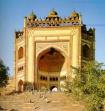Home > Historical houses of asia > Fatehpur sikri
Fatehpur Sikri, India
Fatehpur Sikri, located around 40 kilometers west of Agra, was established by Emperor Akbar in 1569. It was conceived as a grand capital and a testament to Akbar's vision of religious harmony and cultural synthesis. The city's name, Fatehpur Sikri, translates to "The City of Victory," representing Akbar's triumphs and achievements.  |
The architectural splendor of Fatehpur Sikri is a fusion of different styles, reflecting Akbar's inclusive approach to art and architecture. The buildings combine elements of Persian, Indian, and Central Asian styles, resulting in a unique and distinctive architectural blend.
The city is enclosed within fortified walls and consists of several palaces, mosques, public buildings, and residential quarters. The layout of the city is carefully planned, with a centralized core surrounded by various structures and open spaces.
One of the most iconic structures in Fatehpur Sikri is the Buland Darwaza, which stands at an impressive height of 54 meters. It serves as the gateway to the city and features intricate carvings, calligraphy, and Persian inscriptions. The Buland Darwaza is a symbol of Akbar's triumph over Gujarat and a statement of his power and authority.
The Jama Masjid, the principal mosque of Fatehpur Sikri, is a magnificent structure constructed using red sandstone. Its grandeur lies in its vast courtyard, imposing central dome, and intricately designed prayer hall. The mosque exemplifies the artistic prowess of the Mughal architects and showcases a harmonious blend of Islamic and Hindu architectural elements.
The Diwan-i-Khas, or the Hall of Private Audience, is another notable structure within Fatehpur Sikri. This intricately decorated hall served as a meeting place for Akbar and his courtiers. The central pillar, known as the "Lotus Throne," is a masterpiece of craftsmanship, adorned with ornate carvings and motifs.
The Panch Mahal, a five-story palace, is an architectural marvel designed as a pleasure pavilion for the royal women. Its unique design allows for cool breezes to circulate through the open levels, providing respite from the heat. Each level is progressively smaller, giving the Panch Mahal an elegant and graceful appearance.
The tomb of Sheikh Salim Chishti is a revered site within Fatehpur Sikri. It is a white marble mausoleum dedicated to the Sufi saint who was highly regarded by Akbar. The tomb showcases delicate marble lattice work, intricate carvings, and a peaceful ambiance, attracting devotees and visitors seeking blessings.
Apart from these key structures, Fatehpur Sikri is adorned with various palaces, royal residences, gardens, and water features that contribute to its charm and allure. The architecture reflects the Mughal emphasis on aesthetics, grandeur, and meticulous craftsmanship.
Despite its short-lived status as the capital, Fatehpur Sikri remains a testament to the vision and legacy of Emperor Akbar. Its well-preserved structures and architectural finesse continue to captivate visitors, offering a glimpse into the splendor of the Mughal era. Exploring Fatehpur Sikri is an immersive experience that allows one to appreciate the rich history, cultural synthesis, and architectural brilliance of this UNESCO World Heritage Site.









